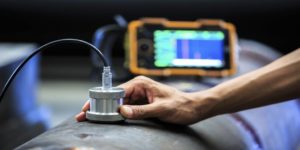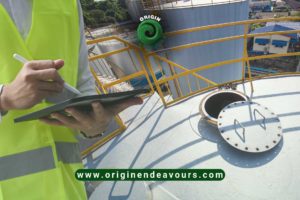Table of Contents
Pressure vessels are essential components of a variety of industrial processes, ensuring the safe and efficient operation of the system. To ensure they are consistently performing as intended, pressure vessels must be inspected regularly.
This comprehensive guide covers the different types of pressure vessel inspections, the benefits of performing them, and the safety measures that must be taken for each. It explains the different inspection methods, the various codes and standards that govern them, and the necessary qualifications and certifications for the personnel performing the inspections. Whether you’re a certified inspector, a facility manager, or a new engineer, this guide will provide you with the information and resources you need to stay informed and compliant.
Benefits of Pressure Vessel Inspections
Pressure vessels must be inspected regularly to ensure they’re performing as intended. Pressure vessel inspection helps prevent leaks, corrosion, and other issues that may negatively affect the vessel’s performance.
It also ensures your vessel is following regulatory codes and standards that ensure safe operation. Here are a few additional benefits of pressure vessel inspections:
- If you’re in charge of ensuring your pressure vessels are performing correctly, an inspection is an essential first step in staying compliant.
- If your vessel is inspected and found to be okay, you can rest easy knowing it’s safe for operation.
- If problems are found, however, you have the opportunity to correct them before they become dangerous, expensive problems that result in costly shutdowns.
Different Types of Pressure Vessel Inspections
Depending on the type of vessel and its intended use, there are different inspection procedures. The most common types of inspections include hydrostatic, mechanical, internal, external, and wall thickness.
Here’s a brief overview of each one:
- Mechanical Integrity Inspections: Vessels used to store liquids or gases at pressures greater than 15 PSIG are usually inspected through a mechanical method. This inspection method is also used when vessels are under pressure but are not designed to store fluid and to check for the instability of vacuum pressure vessels or buckling.
- Hydrostatic Inspections: Vessels that store fluids and are used in process industries often require this inspection and are tested for their leaks as well as strengths. This ensures the vessel is in proper working condition, and that it can safely contain the fluids and gases it’s designed for.
- Internal Inspections: This inspection method involves a visual and physical examination of the vessel’s interior and it is performed when the pressure vessel is empty and not in operation. This includes a visual inspection of the vessel’s welds, materials, and paint job, as well as an examination of the vessel’s internal condition, such as the presence of corrosion.
- External Inspections: External inspections examine the vessel’s surface and paint job. It also includes a visual examination of the structure to examine the working of external components such as inlet piping, vessel connections, outlet piping, and so on.
- Wall Thickness Inspections: The wall thickness method of inspection is used to determine if the vessel is thick enough to safely contain its intended pressure. It’s also used to identify any areas that are susceptible to cracking.
Safety Measures for Pressure Vessel Inspections
Because pressure vessel inspections involve the opening of the vessel, you must take special precautions to ensure the safety of the inspector and the surrounding environment.
Here are a few necessary safety measures: For an inspection to be successful, all safety precautions must be followed. If an inspector is careless and negligent, it could result in a dangerous situation or an inaccurate report. In the most extreme cases, an inspector’s negligence could result in an accident that causes serious injury or death.
Codes and Standards Governing Pressure Vessel Inspections
As you’re preparing for your pressure vessel inspection, you should be aware of certain codes and standards that will be applied to your vessel. Here are some of the most common codes and standards used during inspections: The Society of Automotive Engineers (SAE) codes are used to classify pressure vessels according to their design and intended use. Codes apply to both new and used vessels. It’s important to know the type of code that applies to your vessel, as this will determine the type of inspection required.
Qualifications and Certifications for Inspectors
First and foremost, a pressure vessel inspector must be knowledgeable about pressure vessels and their design. In addition, they must have a general understanding of the industry they’re inspecting to know what is common practice.
An inspector must also be trained and certified in the type of vessel they’re inspecting. To ensure the safety of the vessel and those around it, an inspector must also be qualified and certified in safety.
Here are a few qualifications and certifications an inspector must have:
- To be able to conduct a successful and safe inspection, an inspector must meet the minimum qualifications and have the necessary certifications.
- If an inspector doesn’t meet the minimum qualifications or doesn’t have the necessary certifications, they may be unable to perform the inspection successfully.
- If they don’t perform the inspection correctly, it could negatively affect your operation, and in some cases, pose a safety risk.
Pressure Vessel Inspection Methods
In addition to the various types of inspections, there are several methods of inspecting a pressure vessel. Here are a few of the most common methods:
- Visual: Visual inspections involve a visual examination of the vessel’s surface and structure. For steel vessels, this includes the outside and inside of the vessel. This method of inspection is used for identifying any areas that could be susceptible to corrosion. For cast iron vessels, visual inspections involve examining the outside of the vessel. If the vessel is painted, this includes examining the paint job to ensure it hasn’t been compromised.
- Ultrasonic: Ultrasonic inspections involve sending sound waves into the vessel. These sound waves reflect off the internal structure and are received by a receiver. The time it takes for the sound wave to travel to the vessel and back is used to identify any areas of the vessel that are thicker than they should be. Areas that are thicker than they should be could indicate the presence of corrosion or other defects.
Resources for Pressure Vessel Inspections
As you prepare for your pressure vessel inspection, here are a few resources you can use to stay informed and prepared: The first step to successful pressure vessel inspections is understanding how they work.
By reading this guide and familiarising yourself with the different types of inspections, you’ll be equipped with the knowledge necessary to prepare for your inspection. Additionally, you can contact a certified inspector and ask any questions you have or want to be clarified. By hiring the right inspector, your next pressure vessel inspection will be successful.





